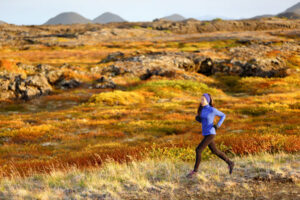Going the Distance: The Perks of Running an Ultramarathon
- By Miriam Wolf
- Reading Time: 5 mins.
Maybe you’ve had your fill of marathons, pounding the pavement alongside thousands of other runners for 26.2 miles, with nothing to fuel your performance but packets of energy goo and orange slices.
 If so, you’re certainly not alone. A growing number of runners in the U.S. and around the world are opting to push themselves even farther and embrace the challenge of an ultramarathon event. According to UltraRunning Magazine, the number of ultra races worldwide skyrocketed over a 10-year period, from 103 races in 1996 to nearly 1,500 in 2016 (the most recent year for which the data was available).
If so, you’re certainly not alone. A growing number of runners in the U.S. and around the world are opting to push themselves even farther and embrace the challenge of an ultramarathon event. According to UltraRunning Magazine, the number of ultra races worldwide skyrocketed over a 10-year period, from 103 races in 1996 to nearly 1,500 in 2016 (the most recent year for which the data was available).
Ultras are different. Yes, you’ll have to run farther than a marathon distance—ultramarathons typically start at 50k, or about 31 miles, and they can extend much longer—but here are a few reasons why, in this runner’s opinion, they are superior events.
- The scenery: Most ultras are run on trails, not roads. Running through the woods, the desert, or up mountains is so much more soul-satisfying and good for mental health than running on a sidewalk. Trail running also increases strength and agility. You use a much wider diversity of muscles to keep yourself upright and moving forward on an uneven, rutted trail than on a smooth and even road. Also, running on more forgiving dirt trails may be easier on the joints than running on concrete.
- Age is not a barrier: In road running, the race goes to the swift, which is usually a young person. Ultramarathons require mental as well as physical strength. It takes discipline and humility to maintain a pace that is sustainable for 50 or 100 kilometers. You can continue to run and enjoy ultra-distance races through your 50s, 60s, and beyond.
- The aid stations: A typical aid station looks more like the snack table at a college mixer than fuel for racers. Pretzels, potato chips, pickles (for their anti-cramp salt content), M&Ms, peanuts, bananas. Cola and ginger ale for goodness’ sake. I knew I wanted to run my first ultramarathon when my trainer mentioned that one ultrarunner he knows used to order pizza to be delivered to him while he was in the middle of a race. (Granted, not the kind of fare a nutrition professional would recommend, but bodies running 30, 50, or even 100 miles at a stretch have radically different calorie needs than athletes running shorter races. Processed foods and sugars don’t tax the digestive system as much as whole grains do. In addition, junk foods like these may be more tempting than sports gels to those whose tummies are upset but need to replenish calories.)
- The community: This is maybe the most compelling reason to sign up for an ultramarathon. When you do, you will become part of one of the most supportive communities in sports. When ultrarunners aren’t on the trail themselves, you’ll find them pacing friends, marking courses, working aid stations, or sweeping races (intentionally placing themselves as the last runner to ensure no competitors are left on the course). Your fellow runners will offer endless encouragement and positivity during a race.
- The lack of crowds. Trail ultramarathons cap their entries so that the number of runners has less impact on fragile woodland trails and because singletrack trails simply don’t accommodate huge numbers of runners. To put it in perspective: around 50,000 runners toe the line at the New York City Marathon each year, while in 2018, the Green Lakes 50K Endurance Run in Fayetteville, NY, had 63 finishers.
 If you already run marathons, you’re likely well on your way to being able to handle the extra miles of a 50K. But you will need to train much differently. For instance, the Boston Marathon, with its legendary “Heartbreak Hill,” gains 985 feet of elevation over 26 miles. My last ultramarathon (Marin County’s Quad Dipsea) increased by more than 9,000 feet of gain in 28 miles.
If you already run marathons, you’re likely well on your way to being able to handle the extra miles of a 50K. But you will need to train much differently. For instance, the Boston Marathon, with its legendary “Heartbreak Hill,” gains 985 feet of elevation over 26 miles. My last ultramarathon (Marin County’s Quad Dipsea) increased by more than 9,000 feet of gain in 28 miles.
In addition, running trails strewn with rocks and roots requires strengthening different types of muscles than running on smooth, flat roads, while balance and agility come into play as well. And you certainly don’t want to forget the recovery piece of your training.
Choosing Your First Ultra
By carefully choosing your first ultra, you can mitigate some of these factors. Consider looking for one with a less aggressive elevation profile or choose one near enough to allow training on the actual race trails. Perhaps you want to start with a trail half marathon to get used to racing on trails, before committing to a full-on ultra. Where do you begin your search? Ultrasignup.com is a one-stop shop for the ultrarunning community, listing hundreds of races around the country.
Yassine Diboun is an ultrarunner who has competed in more than 70 ultramarathons in the past 12 years, including the prestigious Ultra Trail du Mont Blanc in the French Alps. He is the co-owner of a coaching company in Portland, Oregon, The Wy’east Wolfpack. He notes that it’s not only muscles that need to be trained: “I would say that it is important to build up the structural strength to start training for an ultra. Your tendons/ligaments/connective tissues need to be able to withstand the load, and physiological adaptations need to take place with your endurance.”
If you’re interested in becoming an ultra-racer, but not sure if you are ready, Diboun has this advice: “Everyone is different. I would say it definitely helps to have some longer distance experience under your belt,…but there is no equation that says you have to do a marathon before an ultra.”
New to marathons?
Hiring a coach or joining a local ultrarunning group can help you get to the starting line—and the finish line—of your first ultra. To find one, network with your running pals, ask around in the running shoe store, or sign up for a trail 5k or 10k and check out the info tables.
If you find yourself waking up in the middle of the night thinking about how you want to run an ultra, I suggest figuring out a thorough, well-researched training plan to get there without hurting yourself. I remember training for the Boston Marathon back in 2007, and during a run one night, I thought, “I can’t wait till this marathon is over, so I can try one of these ultras!”
Miriam Wolf writes, eats, and runs in Portland, OR. Her favorite fruit is a handful of cherries.


